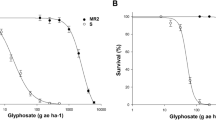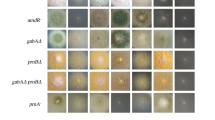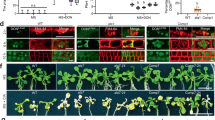Abstract
Herbicide resistance is an important trait often introduced into crop plants. Mechanisms of resistance can involve a mutant target protein that is unaffected by the herbicide, or metabolic detoxification or degradation of the herbicide. Recently, we showed that overexpression in Arabidopsis thaliana of either psNTP9, the garden pea apyrase gene, or AtPgp1, the A. thaliana homolog of the plant multidrug resistance (MDR) gene, enabled A. thaliana to germinate on the toxin cycloheximide and to grow better on toxic levels of the plant hormone N6-[2-isopentyl]adenine (2iP). Here we report that overexpression of either MDR or apyrase proteins resulted in increased resistance to herbicides from different chemical classes. Apyrase inhibition by small molecule inhibitors reversed this resistance. Treatment of untransformed plants with an apyrase inhibitor increased their sensitivity to the same herbicides. These results indicate that the genes may be involved in a resistance mechanism relating to decreased retention or increased active efflux of herbicide from the plant cell.
This is a preview of subscription content, access via your institution
Access options
Subscribe to this journal
Receive 12 print issues and online access
$209.00 per year
only $17.42 per issue
Buy this article
- Purchase on Springer Link
- Instant access to full article PDF
Prices may be subject to local taxes which are calculated during checkout




Similar content being viewed by others
References
Stannard, M.E. & Fay, P.K. Selection of alfalfa seedlings for tolerance to chlorsulfuron. Weed Sci. Soc. America Abstr. 61 (1987).
Sebastian, S.A. & Chaleff, R.S. Soybean mutants with increased tolerance for sulfonylurea herbicides. Crop Sci. 27, 948–952 (1987).
Eastin, E.F. Movement and fate of metribuzin in Tracy and Tracy M soybeans. Proc. South. Weed Sci. Soc. 34, 263–267 (1981).
Darmency, H.M. & Pernes, J. Use of wild Setaria viride (L) Beauv. to improve triazine resistance in cultivated S. italica (L) by hybridization. Weed Res. 25, 175–179 (1985).
Chaleff, R.S. & Ray, T.B. Herbicide-resistant mutants from tobacco cell cultures. Science 75, 5104–5107 (1984).
Anderson, P.C. Cell culture selection of herbicide tolerant corn and its ramifications. in Proceedings of the Forty-First Annual Corn and Sorghum Industry Research Conferences, Publication No. 41 (American Seed Trade Association, Washington, DC, 1986).
Gressel, J. Conferring herbicide resistance on susceptible crops. in Herbicides and Plant Metabolism, Society for Experimental Biology Seminar Series 38 (ed. Dodge, A.) 239–242 (Cambridge University Press, Cambridge, UK, 1989).
Blattner, F.R. et al. The complete genome sequence of Escherichia coli K-12. Science 277, 1453–1474 (1997).
Higgins, C.F. & Gottesman, M.M. Is the multidrug transporter a flippase? Trends Biochem. Sci. 17, 18–19 (1992).
Gros, P. & Hanna, M. The p-glycoprotein family and multidrug resistance: an overview. Handbook of Biological Physics (eds. Konigs, W.N., Kaback, H.R. & Lolkema, J.S.) 7, 137–163 (1996).
Theodoulou, F.L. Plant ABC transporters. Biochem. Biophys. Acta 1465, 79–103 (2000).
Sanchez-Fernandez, R., Davies, T.G.E., Coleman, J.O.D. & Rea, P.A. The Arabidopsis thaliana ABC protein superfamily, a complete inventory. J. Biol. Chem. 276, 30231–30244 (2001).
Dudler, R. & Sidler, M. Arabidopsis MDR genes: molecular cloning and protein chemical aspects. Methods Enzymol. 292, 162–173 (1998).
Sidler, M., Hassa, P., Hasan, S., Ringli, C. & Dudler, R. Involvement of an ABC transporter in a developmental pathway regulating hypocotyl cell elongation in the light. Plant Cell 10, 1623–1636 (1998).
Thomas, C. et al. A role for ectophosphatase in xenobiotic resistance. Plant Cell 12, 519–534 (2000).
Windsor, J.B., Thomas, C., Hurley, L., Roux, S.J. & Lloyd, A.M. An automated screen for apyrase inhibitors. Biotechniques 33, 1024–1030 (2002).
Karasaki, S. & Okigaki, T. Surface membrane nucleoside triphosphatase activity and tumorigenicity of cultured liver epithelial cells. Cancer Res. 36, 4491–4499 (1976).
Ujhazy, P. et al. Evidence for the involvement of ecto-5′-nucleotidase (CD73) in drug resistance. Int. J. Cancer 68, 493–500 (1996).
Gao, L., Dong, L. & Whitlock, J.P. Jr. A novel response to dioxin. J. Biol. Chem. 273, 15358–15365 (1998).
Ostrom, R.S., Gregorian, C. & Insel, P.A. Cellular release of and response to ATP as key determinants of the set-point of signal transduction pathways. J. Biol. Chem. 275, 11735–11739 (2000).
Abraham, E. et al. The multidrug resistance (mdr1) gene product functions as an ATP channel. Proc. Natl. Acad. Sci. USA 90, 312–316 (1993).
Anthony, R.G., Waldin, T.R., Ray, J.A., Bright, S.W.J. & Hussey, P.J. Herbicide resistance caused by spontaneous mutation of the cytoskeletal protein tubulin. Nature 393, 260–262 (1998).
Jasieniuk, M., Morrison, I.N. & Brule-Babel, A.L. Inheritance of dicamba resistance in wild mustard (Brassica kaber). Weed Sci. 43, 192–195 (1995).
Haigler, W.E., Gossett, B.J., Harris, J.R. & Toler, J.E. Resistance of common cocklebur Xanthium strumarium to the organic arsenical herbicides. Weed Sci. 36, 24–27 (1988).
Subramanian, M.V. Engineering dicamba selectivity in crops: a search for appropriate degradative enzyme(s). J. Ind. Microbiol. Biotechnol. 19, 344–249 (1997).
Anthony, R.G., Reichelt, S. & Hussey, P.J. Dinitroaniline herbicide-resistant transgenic tobacco plants generated by co-overexpression of a mutant α-tubulin and a β-tubulin. Nat. Biotechnol. 17, 712–716 (1999).
Shah, D.M. et al. Engineering herbicide tolerance in transgenic plants. Science 233, 478–481 (1986).
Acknowledgements
The authors would like to thank anonymous reviewers for their insightful comments, as well as Kevin Roux and Amanda Rives for work on resistance studies. This work was supported by the Texas Higher Education Coordinating Board, the Herman Frasch Foundation, and the National Science Foundation.
Author information
Authors and Affiliations
Corresponding author
Ethics declarations
Competing interests
The authors are coauthors on patents covering this work. The patents are wholly owned by the University of Texas at Austin and licensed to Texagen, Inc. The authors are part owners of Texagen, Inc.
Rights and permissions
About this article
Cite this article
Windsor, B., Roux, S. & Lloyd, A. Multiherbicide tolerance conferred by AtPgp1 and apyrase overexpression in Arabidopsis thaliana. Nat Biotechnol 21, 428–433 (2003). https://doi.org/10.1038/nbt809
Received:
Accepted:
Published:
Issue Date:
DOI: https://doi.org/10.1038/nbt809
This article is cited by
-
Genome-wide analysis of ATP-binding cassette transporter provides insight to genes related to bioactive metabolite transportation in Salvia miltiorrhiza
BMC Genomics (2021)
-
Non-target site-based resistance to tribenuron-methyl and essential involved genes in Myosoton aquaticum (L.)
BMC Plant Biology (2018)
-
The Phytophthora cactorum genome provides insights into the adaptation to host defense compounds and fungicides
Scientific Reports (2018)
-
Extracellular ATP promoted pollen germination and tube growth of Nicotiana tabacum through promoting K+ and Ca2+ absorption
Plant Reproduction (2018)
-
Target-site and non-target-site based resistance to the herbicide tribenuron-methyl in flixweed (Descurainia sophia L.)
BMC Genomics (2016)



